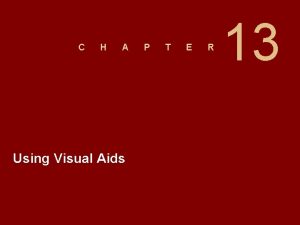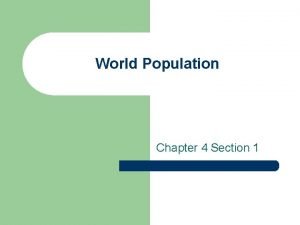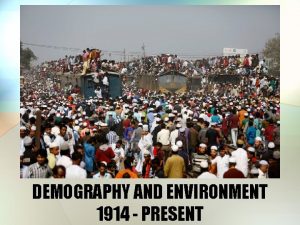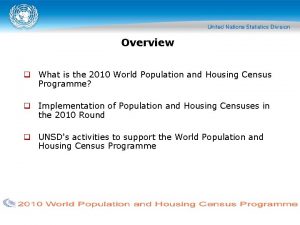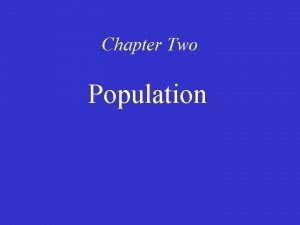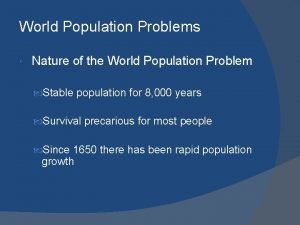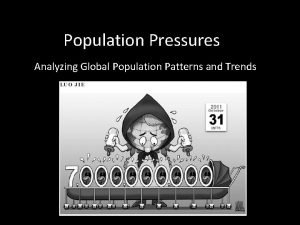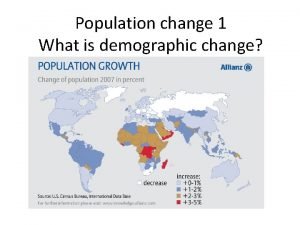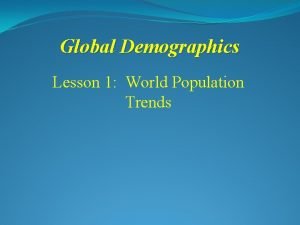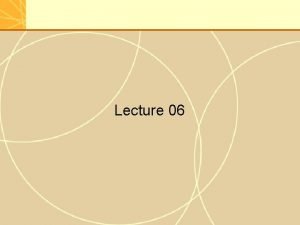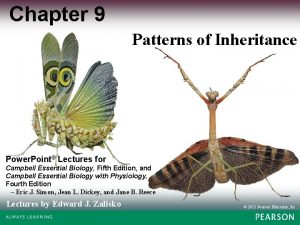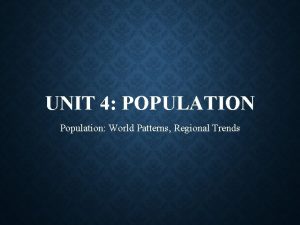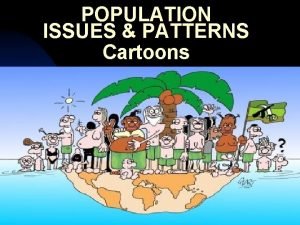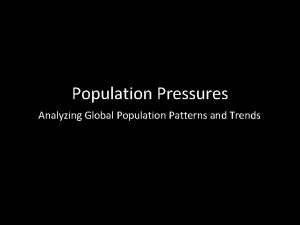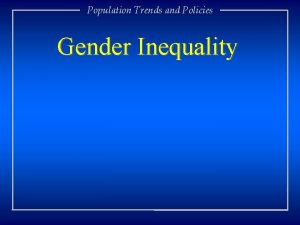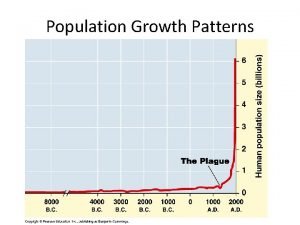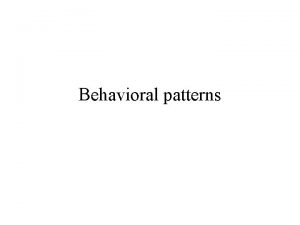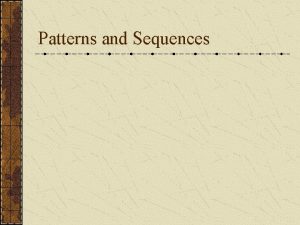Chapter 4 Population World Patterns Regional Trends Population




















































- Slides: 52

Chapter 4 Population: World Patterns, Regional Trends

Population geography: • Focuses on the number, composition, & distribution in relation to variations in the conditions of earth space

Demography differs: • Statistical study of human population • Spatial analysis of the relationship of numbers to area • ratio – proportion – normalized data

Geographic analysis… • Regional considerations include: – Resources – Type of economic development – Level of living – Food supply – Conditions of health & well-being

Why is this important? • 12, 000 years ago = 5 to 10 million • 2006 = over 6. 5 billion humans • UN projection for 2050 = 9. 1 billion • Remember 1 billion = 1, 000 million


Population growth/decline • Births must exceed deaths for growth – Consider the scale – 2. 1 TFR needed to replace present population • Looking at regional growth or decline includes human migration

Three measures of change • 1. Fertility rates – Crude birth rate – Total fertility rate • 2. Mortality rates – Crude death rate – Infant mortality rate • 3. Migration

Population definitions • Rates: – Simply record a frequency of an occurrence during a give time frame for a designated population • Cohort measures: – Refer data to a population group unified by a specified common characteristic

Crude birth rate • Annual number of live births per 1000 population – Considered ‘high’ – 30 > per 1000 – Considered ‘low’ – 18 < per 1000 – Transitional birth rates – 18 to 30 per 1000


Total fertility rate (TFR) • Average number of children that would be born to each woman, if during her childbearing years, she bore children at the current year’s rate • Childbearing ages: 15 to 45 • TFR of 2. 1 to 2. 5 per woman = ‘replacement level’

Total fertility rate (TFR)

Projected % contributions to world population growth by region, 2000 -2050


Crude death rate (mortality rate) • Annual number of events per 1000 population – ‘high’ = > 20 per 1000 – ‘low’ = <10 per 1000 • Post WWII: antibiotics, immunization, pesticides, sanitation, safe water supplies

Infant mortality rate • Deaths age one year or less per 1000 live births • This greatly reflects decline in general death rate numbers • Regional variations can occur within countries


Maternal mortality ratio • Maternal deaths per 100, 000 live births • Single largest health disparity between developing and developed nations • Pregnancy complications, childbirth, abortions = leading killers of women in the 3 rd World

statistics • Developing world: – Africa: 1 in 20 – Sub-Saharan Africa: 1 out of 16 (45% of worldwide deaths) – Latin America & the Caribbean: 1 out of 160 – Angola: 1 in 7 • Europe: 1 in 2400 – Sweden: 1 in 30, 000

Life expectancy • Modern medicine & sanitation • Largest killers today: • Malaria • Intestinal infections • Typhoid • Cholera • AIDS/HIV

Population pyramids • Population composition by age & sex • During 1800 s populations: pyramid shape • Reflects major population impacts


Missing Females…. • 100 million females missing • Aborted • Neglected • Killed • Birth ratio: 106 male babies to 100 females • China, India, Pakistan, New Guinea, other developing nations

China, 2005 India, 2005

Dependency ratio • Simple calculation to measure number of dependents old or young that each 100 people (age 15 -64) must support

Percentage of population under 15 years of age

Rate of natural increase • Derived by subtracting the crude death rate from the crude birth rate (not including change from migration factors) • Expressed as %: – Birth rate of 22 (per 1000) – death rate of 12 (per 1000) = 10 per 1000 or 1%

Doubling time • Rate of increase can be related to the time it takes for a population to double • 1% rate of natural increase = 70 to double • Population growth: geometric (1, 2, 4, 8, 16…) not arithmetic (1, 2, 3, 4, 5, …) • Rule of 70 = 70/growth rate

2004 Annual rates of natural increase

• Remember: » Birth rates, death rates, age structure, collective family size decisions, and migration all effect population growth Global Calculation for Doubling Time

• Mid-1700 s changes really took hold…. » Revolutionary changes in agriculture & food supply » Improvements in medical science, nutrition, & sanitation World Population Growth

Demographic Transition • Portraits the changing levels of human fertility and mortality associated with industrialization & urbanization – Voluntary relationship between population growth & economic development

Stages • 1. High birth rate/high death rate • Population estimated 5 -10 million, 11, 000 years ago • Period of equilibrium » Up and down with wars, famines

Stages • 2. Declining death rates, continuing high birth rates • High dependency ratio • Occurred worldwide without universal conversion to industrial economies » Life expectancy » Low death rates • Birth rates don’t fall due to: » Culture » Agrarian societies » Low status of women

Stages • 3. Birth rates decline, death rates remain low – Industrialization – Urbanization – Birth control

Stages • 4. Very low birth rates & death rates • Back to equilibrium • Natural rate of increase (not migration) • 5. Declining populations • Rich industrialized nations • Heavy burden on small work force • Reverse population pyramids

Demographic equation • Natural change (births – deaths) + net migration (in-migration – outmigration) • In past – emigration was a relief valve for escalating population growth

Immigration impacts • Cross border movements • Past European & African migrations • populated Western Hemisphere & Austral-Asia • Great migration into U. S. during late 1800 s, early 1900 s • 30 -40% population increase • Can cause skewed population balance • Age/gender disparities

Principle migrations of recenturies

Population density • The relationship between number of inhabitants and the areas they occupy

World Population Density

Population dominance of the Northern Hemisphere

Terms • Arithmetic density (crude density) • Calculation of the number of people per unit area of land – usually within political boundaries • Physiological density • Population is divided by arable land » Difficult to define arable land

• Arithmetic density – Non-ecumenes: tundra landscapes = 1/3+ – Due to climate, soils, precipitation factors: non-arable land Northwest Territories, Canada

• Physiological density – Terracing hillside extends arable land Honshu, Japan

Carrying capacity • Number of people an area can support on a sustained basis given the prevailing technology • Concepts: – Overpopulation & density – Technology & carrying capacity – Urbanization

– Over population & density » 1. All cultivated land is used for growing food » 2. Food imports are insignificant » 3. Agriculture is conducted by low-tech methods

– Urbanization • Population shift is largest in world » » 1950 = urban population, 750 million worldwide Early 21 st century = nearly 3 billion urbanites 2030 projection = 5. 1 billion Growth of shantytowns, slums

Percentage of national population that is classified as urban

Population Controls • Female sterilization is most common – India, Brazil, China = > 1/3 married women – Worldwide married male sterilization rate = 4% – Cultural barriers remain » Low status of women / high infant death rates » Religions views » Agrarian societies

 A visual aid used to show statistical trends and patterns.
A visual aid used to show statistical trends and patterns. A visual aid used to show statistical trends and patterns
A visual aid used to show statistical trends and patterns Population ecology section 1 population dynamics answer key
Population ecology section 1 population dynamics answer key Chapter 4 section 1 population dynamics study guide answers
Chapter 4 section 1 population dynamics study guide answers Dating patterns since the 1960s are
Dating patterns since the 1960s are Eclat algorithm
Eclat algorithm Pres wexford geography
Pres wexford geography Ap world history chapter 25 africa and the atlantic world
Ap world history chapter 25 africa and the atlantic world Population ecology section 1 population dynamics
Population ecology section 1 population dynamics Population ecology section 1 population dynamics
Population ecology section 1 population dynamics World history patterns of interaction
World history patterns of interaction Chapter 20 section 2 european nations settle north america
Chapter 20 section 2 european nations settle north america The golden age chapter 18
The golden age chapter 18 World history patterns of interaction
World history patterns of interaction Chapter 9, section 1: labor and wages worksheet answers
Chapter 9, section 1: labor and wages worksheet answers Chapter 1 history and trends of health care
Chapter 1 history and trends of health care Chapter 1 history and trends of healthcare
Chapter 1 history and trends of healthcare Chapter 3 family trends today answer key
Chapter 3 family trends today answer key Chapter 7 section 1 regional economies create differences
Chapter 7 section 1 regional economies create differences Vietnam population clock
Vietnam population clock Guided reading activity 4-1 world population
Guided reading activity 4-1 world population Istj
Istj World population in 1914
World population in 1914 World's population
World's population 2010 world population
2010 world population Cartogram world population
Cartogram world population Four major population clusters
Four major population clusters World population by continent
World population by continent World population by age
World population by age Expansive constrictive and stationary
Expansive constrictive and stationary World population prospects
World population prospects World population
World population World population
World population Primate opposable thumb
Primate opposable thumb Did pumpkins come from the new world or old world
Did pumpkins come from the new world or old world Real world vs digital world
Real world vs digital world The highest of the forms in real world are:
The highest of the forms in real world are: The changing world output and world trade picture
The changing world output and world trade picture History world tour
History world tour An elementary school classroom in a slum rhyme scheme
An elementary school classroom in a slum rhyme scheme Open handed map figure of speech
Open handed map figure of speech English world 3 unit 9
English world 3 unit 9 The changing world output and world trade picture
The changing world output and world trade picture Chapter 20 weather patterns and severe storms
Chapter 20 weather patterns and severe storms Complex patterns of inheritance
Complex patterns of inheritance Chapter 24 patterns of climate answer key
Chapter 24 patterns of climate answer key Chapter 10 urbanization
Chapter 10 urbanization A gene locus is
A gene locus is Chapter 11 section 1 basic patterns of human inheritance
Chapter 11 section 1 basic patterns of human inheritance Chapter 11 section 1 basic patterns of human inheritance
Chapter 11 section 1 basic patterns of human inheritance Dice and coin
Dice and coin Chapter 9 patterns of inheritance
Chapter 9 patterns of inheritance Chapter 20 weather patterns and severe storms
Chapter 20 weather patterns and severe storms
